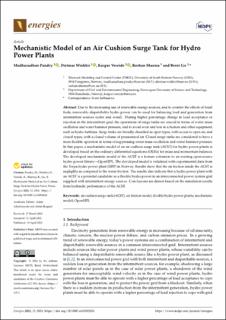| dc.contributor.author | Pandey, Madhusudhan | |
| dc.contributor.author | Winkler, Dietmar | |
| dc.contributor.author | Vereide, Kaspar | |
| dc.contributor.author | Sharma, Roshan | |
| dc.contributor.author | Lie, Bernt | |
| dc.date.accessioned | 2023-04-27T08:00:24Z | |
| dc.date.available | 2023-04-27T08:00:24Z | |
| dc.date.created | 2022-05-15T12:19:30Z | |
| dc.date.issued | 2022 | |
| dc.identifier.citation | Pandey, M., Winkler, D., Vereide, K., Sharma, R. & Lie, B. (2022). Mechanistic Model of an Air Cushion Surge Tank for Hydro Power Plants. Energies, 15(8), Artikkel 2824. | en_US |
| dc.identifier.issn | 1996-1073 | |
| dc.identifier.uri | https://hdl.handle.net/11250/3065224 | |
| dc.description.abstract | Due to the increasing use of renewable energy sources, and to counter the effects of fossil fuels, renewable dispatchable hydro power can be used for balancing load and generation from intermittent sources (solar and wind). During higher percentage change in load acceptance or rejection in the intermittent grid, the operations of surge tanks are crucial in terms of water mass oscillation and water hammer pressure, and to avoid wear and tear in actuators and other equipment, such as hydro turbines. Surge tanks are broadly classified as open types, with access to open air, and closed types, with a closed volume of pressurized air. Closed surge tanks are considered to have a more flexible operation in terms of suppressing water mass oscillation and water hammer pressure. In this paper, a mechanistic model of an air cushion surge tank (ACST) for hydro power plants is developed based on the ordinary differential equations (ODEs) for mass and momentum balances. The developed mechanistic model of the ACST is a feature extension to an existing open-source hydro power library—OpenHPL. The developed model is validated with experimental data from the Torpa hydro power plant (HPP) in Norway. Results show that the air friction inside the ACST is negligible as compared to the water friction. The results also indicate that a hydro power plant with an ACST is a potential candidate as a flexible hydro power in an interconnected power system grid supplied with intermittent energy sources. Conclusions are drawn based on the simulation results from hydraulic performance of the ACST. | en_US |
| dc.language.iso | eng | en_US |
| dc.rights | Navngivelse 4.0 Internasjonal | * |
| dc.rights.uri | http://creativecommons.org/licenses/by/4.0/deed.no | * |
| dc.title | Mechanistic Model of an Air Cushion Surge Tank for Hydro Power Plants | en_US |
| dc.type | Peer reviewed | en_US |
| dc.type | Journal article | en_US |
| dc.description.version | publishedVersion | en_US |
| dc.rights.holder | © 2022 by the authors. | en_US |
| dc.source.pagenumber | 15 | en_US |
| dc.source.volume | 15 | en_US |
| dc.source.journal | Energies | en_US |
| dc.source.issue | 8 | en_US |
| dc.identifier.doi | https://doi.org/10.3390/en15082824 | |
| dc.identifier.cristin | 2024659 | |
| dc.source.articlenumber | 2824 | en_US |
| cristin.ispublished | true | |
| cristin.fulltext | original | |
| cristin.qualitycode | 1 | |

